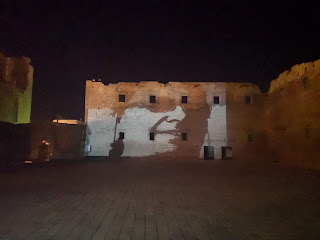A post-residency interview
Curated by Ellada
Before the project had started, Olgu had wanted to work with projections. He found the prospect fascinating, and he had developed a curiosity around the process.
His thinking process involved a lot of back-and-forth at the beginning. He felt that he wanted to tell stories of the city, and as a native of Famagusta, to give them through his own perspective. He acknowledged that every person says these stories differently. In his story, the Owl and the Dragon existed as parallel narratives.
Olgu went into the community and asked people for their feedback in relation to his story. There were people who shared his perspective. So, to his process, the idea of the 'eye' was added , which represented 'the city watching me'. The city was there before he was born, it saw everything, occupations, fight, love, etc.
 |
| Olgu during rehearsal |
Before the project had started, Olgu had wanted to work with projections. He found the prospect fascinating, and he had developed a curiosity around the process.
His thinking process involved a lot of back-and-forth at the beginning. He felt that he wanted to tell stories of the city, and as a native of Famagusta, to give them through his own perspective. He acknowledged that every person says these stories differently. In his story, the Owl and the Dragon existed as parallel narratives.
Olgu went into the community and asked people for their feedback in relation to his story. There were people who shared his perspective. So, to his process, the idea of the 'eye' was added , which represented 'the city watching me'. The city was there before he was born, it saw everything, occupations, fight, love, etc.
I asked him about difficulties during the residency: his school had shown him everything, but this was the chance to get out of his comfort zone of things he does well. He wanted to do something more academic, more formal, and this required discipline which has improved him.
Vasilis and he had wanted to collaborate, but it wasn't possible in the end. but they did help each other.

























